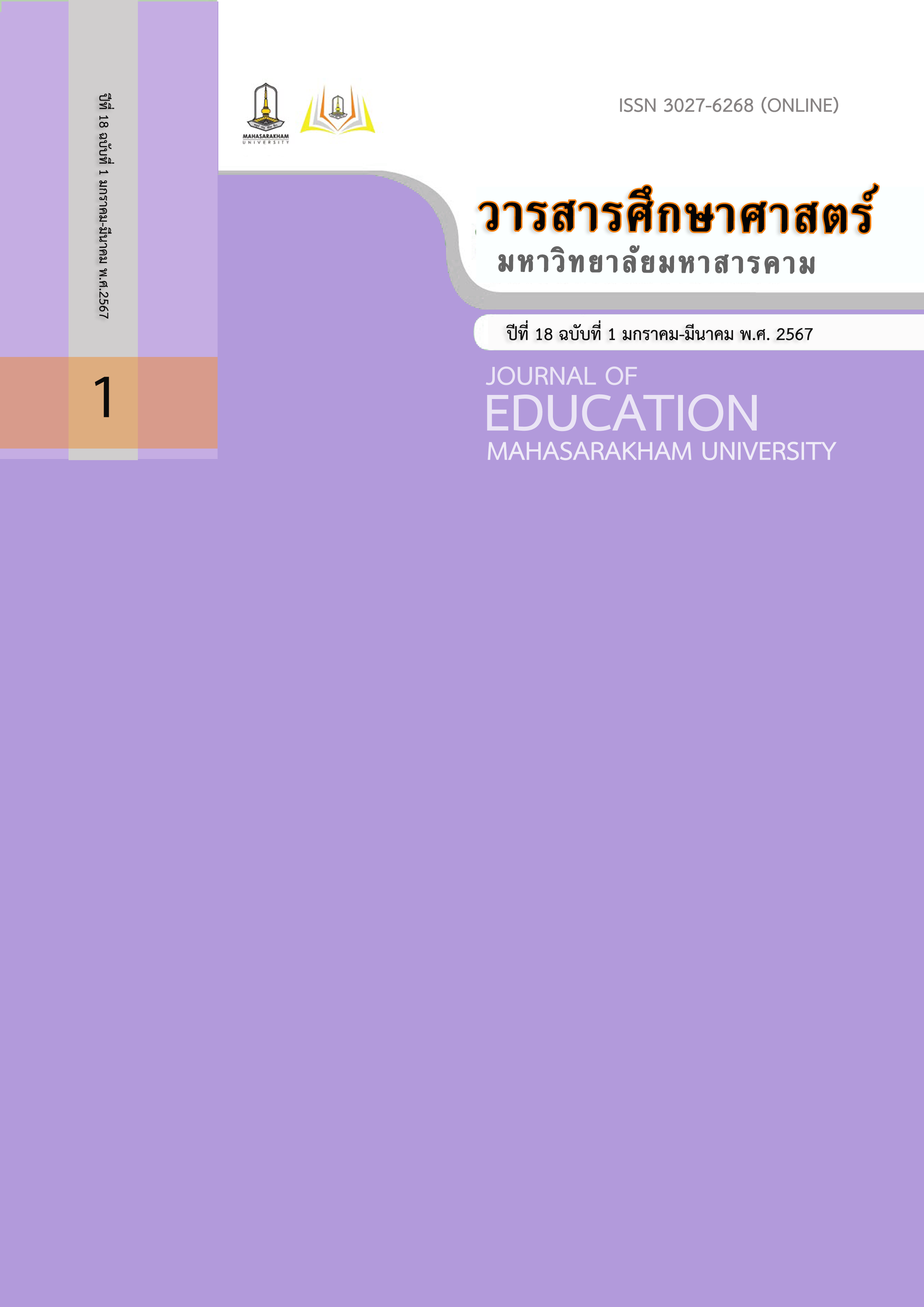Developing in Problem-Solving Skills on the Topics of Addition, Subtraction, Multiplication and Division Problem Solving by the Context-Based Learning with KWDL Technique for Grade 3 Students
Main Article Content
Abstract
This research aimed at: 1) developing the mathematical problem-solving ability of Grade 3 students to pass the achievement criterion of upper 70%, and 70% of all students to pass the same criterion, and 2) developing the mathematic achievement by the context-based with the KWDL technique to pass the achievement criterion of upper 70%, and 70% of all students to pass the same criterion. The target group comprised three students in Grade 13, selected by the purposive sampling from Ban Morn School under Chaiyaphum Primary Educational Service Area Office 2, in Semester 2, 2021 academic Year. The research design was the pre-experimental design. The research instruments included 2 categories: 1) the experimental instruments, covering 6 learning management plans with the KWDL technique for 12 hours, and 2) the instruments for collecting the data, consisting of the problem-solving skills test in the subjective test form comprising 10 items (p = 0.55-0.75, r = 0.20-0.80, rcc = 0.71), and the multiple-choice objective test covering 20 items, with the difficulty value (p) between 0.45-0.80, the discrimination value (r) between 0.20-0.80, and the reliability value (rcc) in overall paper equaled 0.86. The statistics for data analysis included the mean, standard deviation, and the percentage.
The research findings disclosed that: 1) for the mathematic problem-solving ability of the students on the topics of addition, subtraction, multiplication and division problem solving by the context-based learning with the KWDL technique, the mean score implied 39.69 equalling 79.21% and 13 students could pass the setting criterion which equalled 100% of all students. 2) for the mathematic learning achievement of Grade 3 students by the context-based learning with the KWDL technique, the mean score equalled 14.54 with 72.69%, 11 students could pass the setting criterion which equalled 84.62% of all.
Downloads
Article Details

This work is licensed under a Creative Commons Attribution-NonCommercial-NoDerivatives 4.0 International License.
References
กระทรวงศึกษาธิการ. (2551). หลักสูตรแกนกลางการศึกษาขั้นพื้นฐาน พุทธศักราช 2551. กรุงเทพฯ : โรงพิมพ์ชุมชนการเกษตรแห่งประเทศไทย.
กระทรวงศึกษาธิการ. (2560). ตัวชี้วัดและหลักสูตรแกนกลาง กลมสาระการเรียนรู้วิทยาศาสตร์ (ฉบับปรับปรุง พ.ศ. 2560) ตามหลักสูตรแกนกลางการศึกษาขั้นพื้นฐาน พุทธศักราช 2551. กรุงเทพฯ: โรงพิมพ์ชุมนุมสหกรณ์การเกษตรแห่งประเทศไทย.
จินดา พราหมณ์ชู. (2553). การพัฒนากิจกรรมการเรียนรู้โดยใช้บริบทเป็นฐาน เรื่อง อัตราการเกิดปฏิกิริยาเคมี สำหรับนักเรียนชั้นมัธยมศึกษาปีที่ 5.กรุงเทพฯ: มหาวิทยาลัยเกษตรศาสตร์.
จิราวรรณ เทพจินดา และคณะ. (2565). การศึกษาสภาพการเรียนการสอนคณิตศาสตร์ที่เกี่ยวข้องกับการตั้งปัญหาทางคณิตศาสตร์ของนักศึกษาครูคณิตศาสตร์ อาจารย์และครูพี่เลี้ยง. วารสารชุมชนวิจัย มหาวิทยาลัยราชภัฏนครราชสีมา, 16(1), 154-166.
ชญาณิศา เป็งจันทร์ นพพร ธนะชัยขันธ์ และสุดาพร ปัญญาพฤกษ์. (2560). ศึกษาการจัดการเรียนรู้โดยใช้เทคนิค KWDL เพื่อพัฒนาผลสัมฤทธิ์ทางการเรียนคณิตศาสตร์ เรื่องโจทย์ปัญหาของนักเรียนชั้นประถมศึกษาปีที่ 6. วารสารบัณฑิตวิจัย มหาวิทยาลัยราชภัฏเชียงราย, 8(1), 71-82.
ชรินดา สุขแสนชนานันท์. (2555). การพัฒนาแนวคิดและความสามารถในการถ่ายโอนแนวคิดเรื่อง พลังงานความร้อนของนักเรียนชั้นมัธมศึกษาตอนต้น โดยการจัดการเรียนรู้แบบอิงบริบท. ปริญญาศึกษาศาสตรมหาบัณฑิต (วิทยาศาสตร์ศึกษา). บัณฑิตวิทยาลัยมหาวิทยาลัยเกษตรศาสตร์.
ชัยวัฒน์ สุทธิรัตน์ . (2558). 80 นวัตกรรมการจัดการเรียนรู้ที่เน้นผู้เรียนเป็นสำคัญ. พิมพ์ครั้งที่ 5 .กรุงเทพฯ : แดเน็กซ์ อินเตอร์คอร์ปอเรชั่น.
ปรณัฐ กิจรุ่งเรือง และวัชรา เล่าเรียนดี. (2554). การพัฒนารูปแบบการสอนโดยใช้กรณีศึกษาทางศาสตร์การเรียนการสอนเพื่อส่งเสริมความสามารถด้านการคิดอย่างมีวิจารญาณของนักศึกษาวิชาชีพครู. วารสารศิลปากรศึกษาศาสตร์วิจัย, 3(1), 109-121.
พิเชษฐ เทบํารุง. (2557). การพัฒนารูปแบบการเรียนการสอนวิชาเคมี ตามแนวคิดการเรียนรู้โดยใช้บริบทและปัญหาเป็นฐาน สำหรับนักศึกษาหลักสูตรปริญญาบัณฑิต. วิทยานิพนธ์ ปริญญาดุษฎีบัณฑิต มหาวิทยาลัยราชภัฏสกลนคร.
พิมพิชา เอกพันธ์และมนตรี ทองมูล. (2563). การพัฒนาการรู้เรื่องคณิตศาสตร์ของนักเรียนชั้นมัธยมศึกษาปีที่5 เรื่องทฤษฎีกราฟเบื้องต้น ด้วยกิจกรรมการเรียนรู้โดยใช้บริบทเป็นฐาน. วารสารมหาจุฬานาครทรรศน์. 7(9), 111-125.
โรงเรียนบ้านมอญ. (2563). รายงานการประเมินตนเองของสถานศึกษาขั้นพื้นฐาน ปีการศึกษา 2562. ชัยภูมิ: โรงเรียนบ้านมอญ.
ล้วน สายยศ, และอังคณา สายยศ. (2543). เทคนิคการวิจัยทางการศึกษา. กรุงเทพฯ: สุวีนิยาสาสน์.
สถาบันส่งเสริมการสอนวิทยาศาสตร์และเทคโนโลยี. (2551). ทักษะ/กระบวนการทางคณิตศาสตร์.กรุงเทพฯ: ส.เจริญการพิมพ์.
สถาบันส่งเสริมการสอนวิทยาศาสตร์และเทคโนโลยี. (2555). การจัดการเรียนรู้กลุ่มวิทยาศาสตร์หลักสูตรการศึกษาขั้นพื้นฐาน. กรุงเทพฯ: สถาบันส่งเสริมการสอนวิทยาศาสตร์และเทคโนโลยี.
เอกรัตน์ ศรีตัญญู. (2555). การจัดการเรียนรู้โดยใช้บริบทเป็นฐานในวิชาเคมี. ศึกษาศาสตร์ปริทัศน์. 27 (2): 33-47.
Bennett, Judith; & Holman, John. (2002). Context-based Approaches to the Teaching of Chemistry : What are they and What are their Effect?. In Chemical Education: Toward Research-based Practice. Netherlands: Kluwer Academic Publishers.
Bloom, B. (1976). Self-regulation of action and affect. In Roy F. Baumeister and Kathleen D. Vohs. Handbook of Self-Regulation. New York: The Guilford Press.
Crawford, M. L. (2001). Teaching Contextually: Research, Rationale, and Techniques for Improving Student Motivation and Achievement in Mathematics and Science. Texas: CCI Publishing, Inc.
Darkwah, V.A. (2006). Undergraduate nursing student’level of thinking and self–efficacy in patient education in Context-based learning Program. Dissertation M.N. (Nursing) Alberta. Faculty of Nursing, University of Alberta.
De Jong, O. (2006.Making chemistry meaningful: Conditions for successful contextbased teaching. Education Quimica, 17, 215–221.
Gillbert, J. K. (2006). On the nature of “context” In chemistry education. International Journal of Science Education, 28(29), 957-976.
Polya, George. (1985). How to Solve It. New Jersey: Prince to University Press.
Seel, N. M. (2012). Encyclopedia of the science of learning. London: Springer Science + Business Media.


